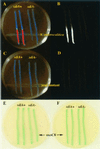SdiA of Salmonella enterica is a LuxR homolog that detects mixed microbial communities
- PMID: 11544237
- PMCID: PMC95466
- DOI: 10.1128/JB.183.19.5733-5742.2001
SdiA of Salmonella enterica is a LuxR homolog that detects mixed microbial communities
Abstract
Proteins of the LuxR family detect the presence of N-acylhomoserine lactones (AHLs) and regulate transcription accordingly. When AHLs are synthesized by the same species that detects them, the system allows a bacterium to measure the population density of its own species, a phenomenon known as quorum sensing. The sdiA genes of Escherichia coli and Salmonella enterica serovar Typhimurium are predicted to encode LuxR homologs. However, these species do not appear to synthesize AHLs or any other molecule detected by SdiA. It has previously been demonstrated that overexpression of sdiA results in the activation of the ftsQAZ locus in E. coli and four other loci in Salmonella serovar Typhimurium. Here we report that transcriptional fusions to these five loci fall into two classes. The first class requires overexpression of sdiA for activation. The second class responds to sdiA expressed from its natural position in the chromosome if the appropriate AHLs are added to the culture. The only member of the second class is a series of Prck-luxCDABE fusions in Salmonella serovar Typhimurium. SdiA responds with highest sensitivity to AHLs that have a keto modification at the third carbon and an acyl chain length of 6 or 8 (half-maximal response between 1 and 5 nM). Growth of Salmonella in proximity to species known to synthesize these AHLs results in sdiA-dependent activation of the Prck-luxCDABE fusions. SdiA appears to be the first AHL receptor discovered that detects signals emanating exclusively from other species.
Figures






Similar articles
-
Synthesis of N-acyl homoserine lactone analogues reveals strong activators of SdiA, the Salmonella enterica serovar Typhimurium LuxR homologue.Appl Environ Microbiol. 2007 Jan;73(2):535-44. doi: 10.1128/AEM.01451-06. Epub 2006 Nov 3. Appl Environ Microbiol. 2007. PMID: 17085703 Free PMC article.
-
Detection of other microbial species by Salmonella: expression of the SdiA regulon.J Bacteriol. 2003 Feb;185(4):1357-66. doi: 10.1128/JB.185.4.1357-1366.2003. J Bacteriol. 2003. PMID: 12562806 Free PMC article.
-
Effect of sdiA on biosensors of N-acylhomoserine lactones.J Bacteriol. 2005 Jul;187(14):5054-8. doi: 10.1128/JB.187.14.5054-5058.2005. J Bacteriol. 2005. PMID: 15995228 Free PMC article.
-
Eavesdropping by bacteria: the role of SdiA in Escherichia coli and Salmonella enterica serovar Typhimurium quorum sensing.Foodborne Pathog Dis. 2011 Feb;8(2):169-78. doi: 10.1089/fpd.2010.0651. Epub 2010 Oct 30. Foodborne Pathog Dis. 2011. PMID: 21034261 Review.
-
Role of the LuxR solo, SdiA, in eavesdropping on foreign bacteria.FEMS Microbiol Rev. 2025 Jan 14;49:fuaf015. doi: 10.1093/femsre/fuaf015. FEMS Microbiol Rev. 2025. PMID: 40240290 Free PMC article. Review.
Cited by
-
The acyl homoserine lactone receptor, SdiA, of Escherichia coli and Salmonella enterica serovar Typhimurium does not respond to indole.Appl Environ Microbiol. 2012 Aug;78(15):5424-31. doi: 10.1128/AEM.00046-12. Epub 2012 May 18. Appl Environ Microbiol. 2012. PMID: 22610437 Free PMC article.
-
Natural and synthetic inhibitors of a phage-encoded quorum-sensing receptor affect phage-host dynamics in mixed bacterial communities.Proc Natl Acad Sci U S A. 2022 Dec 6;119(49):e2217813119. doi: 10.1073/pnas.2217813119. Epub 2022 Nov 29. Proc Natl Acad Sci U S A. 2022. PMID: 36445970 Free PMC article.
-
The Subtleties and Contrasts of the LeuO Regulator in Salmonella Typhi: Implications in the Immune Response.Front Immunol. 2014 Dec 12;5:581. doi: 10.3389/fimmu.2014.00581. eCollection 2014. Front Immunol. 2014. PMID: 25566242 Free PMC article. Review.
-
SdiA Improves the Acid Tolerance of E. coli by Regulating GadW and GadY Expression.Front Microbiol. 2020 Jun 3;11:1078. doi: 10.3389/fmicb.2020.01078. eCollection 2020. Front Microbiol. 2020. PMID: 32582066 Free PMC article.
-
Molecular Mechanisms and Applications of N-Acyl Homoserine Lactone-Mediated Quorum Sensing in Bacteria.Molecules. 2022 Nov 4;27(21):7584. doi: 10.3390/molecules27217584. Molecules. 2022. PMID: 36364411 Free PMC article. Review.
References
-
- Bassler B L, Wright M, Showalter R E, Silverman M R. Intercellular signalling in Vibrio harveyi: sequence and function of genes regulating expression of luminescence. Mol Microbiol. 1993;9:773–786. - PubMed
-
- Blattner F R, Plunkett III G, Bloch C A, Perna N T, Burland V, Riley M, Collado-Vides J, Glasner J D, Rode C K, Mayhew G F, Gregor J, Davis N W, Kirkpatrick H A, Goeden M A, Rose D J, Mau B, Shao Y. The complete genome sequence of Escherichia coli K-12. Science. 1997;277:1453–1474. - PubMed
-
- Chhabra S R, Stead P, Bainton N J, Salmond G P, Stewart G S, Williams P, Bycroft B W. Autoregulation of carbapenem biosynthesis in Erwinia carotovora by analogues of N-(3-oxohexanoyl)-l-homoserine lactone. J Antibiot. 1993;46:441–454. - PubMed
Publication types
MeSH terms
Substances
Grants and funding
LinkOut - more resources
Full Text Sources
Other Literature Sources
Molecular Biology Databases

